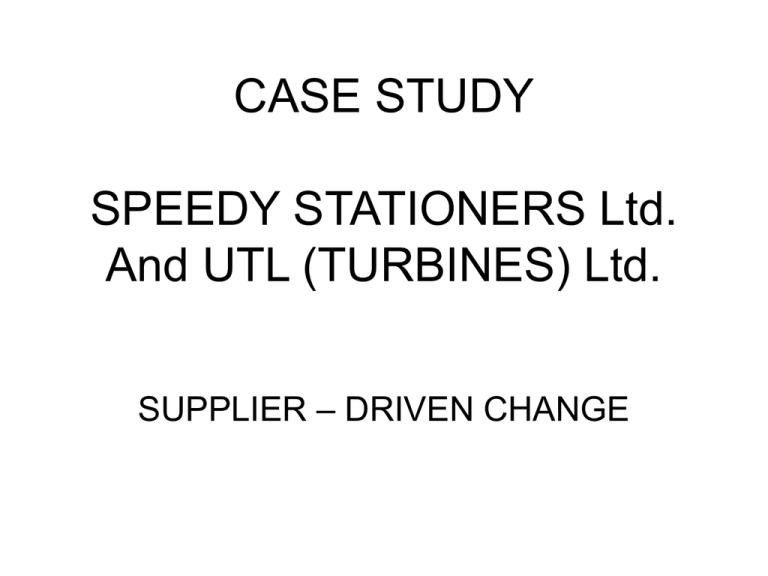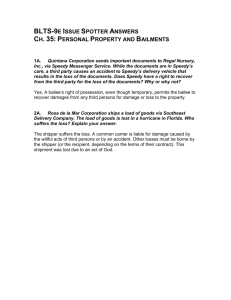CASE STUDY SPEEDY STATIONERS Ltd. And UTL (TURBINES) Ltd. – DRIVEN CHANGE
advertisement

CASE STUDY SPEEDY STATIONERS Ltd. And UTL (TURBINES) Ltd. SUPPLIER – DRIVEN CHANGE Learning Obrjectives 1. Understand how real life organizations develop and implement strategy 2. Show how staff can be motivated or demotivated by different approaches to strategic change 3. Appriciate the managers can exercise considerable choice in terms of their organizations strategy Background Speedy Stationers the development of a partnership between Speedy Stationers Ltd. And UTL (Turbines) Ltd, whereby the former took responsibility for the provision and in-company management of all UTL’s stationery requirements. Speedy Stationers was founded in 1953, and in 1994 had turnover of roughly L 50 milion. Orginialy the firm acted just as a wholesaler selling to distributors and retails. In the mid1980s, almost by accident (an acquaintance of the managing director happened to appointed to the same position in UTL) Partly influenced by possibility of selling directly to large companies. Speedy embargked on an expasion programme in the late 1980s tha doubled its number of distribution centres from three to six. This geographical spreading of risk allowed the company to wether to recession of the early 1990s without any significant loss of business – thouggh its profit margins were squeezed.Nevertheless, by 1993, senior managers came to recognice that the possibilities of contiued expansion through the establishment of more distribution centres was limited, as well as expensive A Strategy emerges The strategy that emerged had three objectives : 1. To offer a complete stationery service to its existing customers, including printed letterheads, forms, etc. 2. To develop partenerships with its customers whereby the direct slaes division would supply and manage their stationery stock 3. To triple turnover in three years whilst maintaining its profit margin The thinking behind this strategy 1. 2. 3. 4. The turnover of direct business was L 750.000 from 15 customers Direct customers were mainly located near its headquaters in Birmingham and therefore could easily be serviced by one group of staff. Speedy only accounted for 20-25 per cent of direct customers’ stationery requirements, because it did not provide printed stationery. In the early 1990s, the concept of partnerships between suppliers and customers began to take off, the wholesale business was discussing managing the inventory for a numberof medium-sized distributors, so it did not seem totally unfeasible to offer a similar service to direct customers UTL (Turbines) Ltd. The company is part of large multinational group, and serve markets worldwide, UTL (Turbines), as its name implies, is the division responsible for the design and manufacture of turbines, which are supplied to a wide range of industrial users. Like many manufacturing operations in the UK, the plant had experienced severe reductions in the number of people employed. From over 1.500 in 1987, the number working at the factory by 1994 had shrunk to about 900. In 1992, two different aspects of business – export and domistic turbine – merged their operations Speedy takes the inisiative By 1993, the reorganisation and reorientation of UTL’s Purchasing departement was well under way. In particular, the seminar series, which at first attracted some adverse comment within the company, was proving a key vehicle for introducing new idea and generating fresh thinking. When the director for direct sales at speedy heard about the seminar programme, he offered to come and talk about its new approach to working with customers. Toward the end of 1993, Speedy and UTL signed atho-year contract covering the provision of all stationery requirements from the beginning of 1994. Though the contract included certain specific details, it was acknowledge that most of the mechanics of arragement would only emerge as the system was implemented Implementing the new system The new system entails significant reductions in the bureaucracy of supplying stationery, but also challenges many traditional approaches to buyer-supplier relationship, especially in relation to trust. 1. In the absence of direct checks, UTL has to have complete confidence in the equality of product supplied by Speedy and the reliability of its operation 2. UTL has totrust that Speedy is actually dilivering what it is invoicing for 3. UTL has to be sure that a single-source supplier will not exploit its position and introduce opportunistic price rises The Benefit to 1. • Speedy It increased its business with UTL from approximately L 50.000 per year to over L 200.000, and actualy improved its profit margin to 8.5 per cent • It proved that the new arrangement could work, and had three other customers keen to develop similar arrangement 2. UTL • It made a 20 per cent saving on its annual stationery bill – twice as much as aticipated, even taking account of using up old stock • Consumption of stationery decline in home usege as one manager put it • The number of complaints relating to stationery dwindled almost to zero. summary 1. 2. 3. 4. What this case shows is that customers and suppliers can link together consciuosly to change the nature of the environmet in which they operate to their mutual benefit The study also shows the serendipitous and unplanned anture of much of business life. The manner in which suspicion and resistance were overcome is also worth noting. Another major point is that both parties were prepared to set aside the distrust that permeates so many business relationships, and attempt to establish a partnership based on trust.
